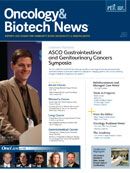Publication
Article
Oncology & Biotech News
Targeted Therapies in Breast Cancer Offer Increasing Hope and Complexity
Author(s):
As research progresses, optimal treatment of breast cancer will involve individualization of therapy to focus on specific targets driving each patient's cancer.
Brian Leyland-Jones, MD, PhD
Treatment of breast cancer is becoming “horrendously complicated,” according to Brian Leyland-Jones, MD, PhD, director, Winship Cancer Institute at Emory University in Atlanta, Georgia. Leyland-Jones, who spoke at the 9th Annual Northern New Jersey Breast Cancer Conference, held at the John Theurer Cancer Center in February, explained that as research progresses, optimal treatment of breast cancer will involve individualization of therapy to focus on specific targets driving each patient’s cancer. “It is becoming clear that breast cancer has 50 to 80 targetable drivers,” he said.
“This is a time of massive knowledge change in the entire field,” said Leyland-Jones, noting that research is progressing so rapidly that it’s almost becoming impossible to remember all the targeted areas. Advances in both basic research and translational research are producing a plethora of new targets. “The number of targets is shooting up, but fortunately we are getting the drugs to handle those targets,” said Leyland-Jones.
One promising advancement is the development of T-DM1 (also called trastuzumab emtansine, Roche) for HER2-positive disease. T-DM1 is an antibody-drug conjugate (ADC) in which trastuzumab (Herceptin, Genentech) is attached to the chemotherapy DM1 using a stable linker. Results of a phase II trial, presented at the San Antonio Breast Cancer Symposium (SABCS) in December, evaluated first-line therapy with either trastuzumab/docetaxel or T-DM1 in patients with HER2-positive metastatic breast cancer. Compared with trastuzumab/docetaxel, T-DM1 significantly improved progression-free survival (PFS) (median PFS for trastuzumab/docetaxel 9.2 months vs 14.2 months for T-DM1; HR = 0.594; 95% CI, 0.364-0.068; P = .0353). There was significantly less toxicity with T-DM1. At least two ongoing trials (EMILIA and MARIANNE) are continuing to evaluate use of T-DM1 in HER2-positive metastatic breast cancer.
The pivotal phase III CLEOPATRA trial, also presented at SABCS, demonstrated a significant improvement in PFS for dual HER2 inhibition using trastuzumab and pertuzumab. The survival impact demonstrated in the study will be “practice-changing,” said Leyland-Jones.
Many additional targets are under development for breast cancer therapies, including PARP inhibitors, which may have efficacy in BRCA-associated cancer. In a phase III trial published in January 2011, the PARP inhibitor iniparib (BiParSciences/sanofi-aventis), did not meet the primary dual endpoints of overall survival (OS) and PFS in metastatic triple-negative breast cancer. However, a pre-specified subgroup analysis suggested improvements in OS and PFS in the second- and third-line settings, and research on iniparib continues. Iniparib is considered a relatively weak PARP inhibitor, said Leyland-Jones, but it “works in terms of helping DNA repair. The driving force of cancer is DNA repair.”
Other PARP inhibitors under development include rucaparib (Clovis), for BRCA-positive, post-neoadjuvant triple-negative breast cancer; olaparib (AstraZeneca), for BRCA-positive breast cancer; and veliparib (Abbott), for BRCA-positive, triple-negative breast cancer.
Advances in basic research are leading to a greater understanding of the tumor microenvironment, noted Leyland-Jones. New therapeutic targets as a result of these advances include metabolic pathways (serine, glycine synthesis), JAK2 in triple-negative and potentially other breast cancers, androgen receptors in HER2- positive breast cancer; SRC in trastuzumab resistance; and use of large-scale siRNA screens to identify and validate targets.
Advances in translational research have recently led to work on overcoming endocrine therapy resistance, overcoming HER2-targeted therapy resistance, and classification and prognosis in triple-negative breast cancer.
Over the next five years, therapy will increasingly be based on genome sequencing, said Leyland-Jones. The cost of sequencing is also expected to drop, along with the time it takes to see results, he said, with results available within two weeks.
The impact of emerging new therapies will be significant, according to Leyland-Jones. “Breast cancer will be transformed in our lifetimes.”




























%20(2)%201-Recovered-Recovered-Recovered-Recovered-Recovered-Recovered-Recovered-Recovered-Recovered-Recovered-Recovered-Recovered-Recovered-Recovered-Recovered-Recovered-Recovered.jpg?fit=crop&auto=format)
%20(2)%201-Recovered-Recovered-Recovered-Recovered-Recovered-Recovered-Recovered-Recovered-Recovered-Recovered-Recovered-Recovered-Recovered-Recovered-Recovered-Recovered-Recovered.jpg?fit=crop&auto=format)
